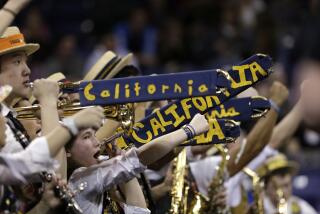San Diego State Panel Suggests Mascot Changes
- Share via
SAN DIEGO — Monty Montezuma, the controversial mascot of San Diego State, could get a new name, a new costume and a more serene demeanor under a recommendation Wednesday by a task force charged with advising the university president.
The task force, on a split vote, recommended a plan in which the Montezuma character, played by a student, could continue to attend football and basketball games but would dress and act more like the real Aztec ruler.
No more would he run along the sidelines during football games, spitting fire, flinging his spear into the ground, and exhorting fans to cheer. His loincloth and peacock feather headdress might be replaced by a simple tunic and cape.
And he would be known as Montezuma the university ambassador, not Monty Montezuma the mascot.
The final decision rests with President Stephen Weber, who ruled in November that Montezuma could remain but would be portrayed in a more historical manner. Weber’s decision is expected within two weeks.
The controversy erupted last fall when a group of Native American students at San Diego State demanded that Monty Montezuma be dropped as a demeaning and racist portrayal. Alumni and students rallied in support of retaining Monty and the Aztec team name.
Bill Trumpfheller, president of the university alumni association, said he hoped the task force recommendations, if adopted by Weber, could make the Montezuma character more acceptable to the activists “without breaking the bonds and traditions that so many hold dear.”
But the task force’s recommendation was immediately denounced by some Latino students.
“Montezuma was a warrior king,” said Mirna Hernandez, chairwoman of the San Diego State branch of MEChA, a Chicano group. “He did not go to football games.”
The task force recommendation appears contrary to a recent recommendation by the U.S. Commission on Civil Rights that non-Indian schools stop using Indian names for team names and mascots.
Tom Davies, professor of Latin American history at San Diego State, one of three co-chairmen of the task force, said that a more historically accurate portrayal of Montezuma would have him carried aloft on a litter and remain observant but wordless during the football game.
To be even more accurate, Davies said, his subjects would not be allowed to look at him.
Although historians disagree on numerous details about the 16th century ruler--including whether he was killed by his own subjects or by the Spanish invaders--there is a consensus that Montezuma II was a contemplative, melancholy philosopher king who often gazed into the stars for advice.
Monty Montezuma made his first appearance in 1941 at the halftime of the San Diego-Pomona College football game. The college’s athletic teams have been called Aztecs since 1925.
For many years, Monty was displayed in a manner not unlike that suggested by the task force--a regal presence perched atop a pyramid.
More recently, a succession of muscular male students have portrayed Monty as a sexier, more active figure. His dramatic arrival on the field at Qualcomm Stadium rarely fails to bring Aztec fans to their feet.
Along with suggesting changes in the Montezuma character, the task force recommended that the red-faced, menacing likeness of Montezuma that appears on various souvenirs be modified to be more historically accurate and that the university explore finding another kind of mascot to be a cheerleader at athletic contests.
“We’ve got to grow up and stop talking about redskins and Injuns,” said Davies.
Possible mascots could include an eagle, a jaguar or a rattlesnake, all animals linked to Aztec culture, task force members said. Use of the nickname “Monty” was seen as overly familiar and disrespectful.
The task force of 20 included students, faculty members, alumni and community residents. A minority of the committee opposed the use of Montezuma in any form. Amid passionate debate, students voted overwhelmingly last year to recommend the retention of Monty.
“The student referendum was amazing,” Davies said. “I’ve been here for 33 years and I’ve never seen 8,000 [students] turn out for anything.”
More to Read
Sign up for Essential California
The most important California stories and recommendations in your inbox every morning.
You may occasionally receive promotional content from the Los Angeles Times.













